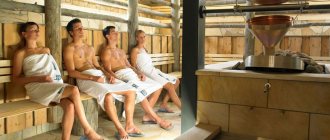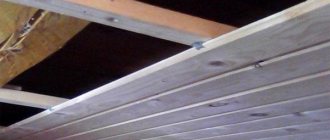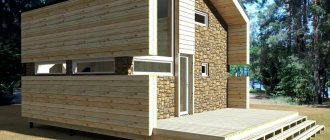Before starting construction of a sauna, it is important to decide on the material, which is better for a bath, linden or aspen, choose alder or cedar. There are many options for wood for walls and decoration, and they are all interesting and attractive in their own way. Each type of wood has its own advantages and disadvantages, so using only one type, for example, cedar for a bathhouse, will not be entirely correct. Even if it seems that facing the walls with steamed aspen is no better than finishing with cedar.
How to compare materials correctly
Of course, there are financial resources and time, quite realistically, and universal solutions. For example, build a log bathhouse from cedar, preferably Canadian, and use African oak to decorate the steam room. Even with a successful design, steaming in such a bathhouse is not much better or more comfortable than in a regular one, but it will last ten times longer than a log house made of aspen or even larch. But such a box will be very expensive. Perhaps, with the money spent on arranging such a bathhouse, it would be better to build four full-fledged wooden saunas made of cedar pine and linden.
Wood used in bath construction is divided into three categories:
- Finishing material for steam room walls, shelves, bath accessories;
- Material for arranging the wettest parts of the bathhouse;
- Wall block or timber.
This division did not arise by chance; as a rule, a certain type of wood performs best under certain conditions. For example, oak or larch are better suited than pine or alder for a bathhouse when it comes to constructing a log house or building frame. At the same time, heavy oak, acacia or birch are never used for wall decoration of the steam room. The denser the wood, the more it burns the skin, and birch board also produces bitterness.
Rules for processing lining
Lamels are perfect for cladding both inside and outside the building. Additional treatment of boards with antiseptics is not necessary, however, many owners still decide to play it safe and use these products and several other methods to increase the decorative properties of surfaces.
This:
- Polishing boards. This way they get rid of roughness and become smooth and with a soft shine. Calm and standard looks good on flat panels.
- Varnishing. For this, colorless varnish is most often used, since the wood itself has a rich, noble color.
- Aging. This technique is also called structuring - it makes the structure of the wood more expressive and adds a unique aesthetics.
What is better to pay attention to
When choosing a material, in addition to price and tactile perception of the wood surface when touched, you need to pay attention to two important points:
- Wood workability;
- Resistance of the material to moisture and high temperature;
- Decorative qualities and smell.
All three categories have their leaders and outsiders. For example, linden and aspen have the best workability, cedar and larch are considered to be moisture-resistant, alder and abash are considered the most beautiful and comfortable to touch.
Of course, there are universal types of wood, the qualities of which are no better than those of the leaders, but they can be used to a certain extent for any parts of the bathhouse. Such materials include aspen, larch and cedar.
Covering the steam room with larch
When selecting cladding for a bathhouse, it is important to remember that you need to choose one material to finish all the surfaces inside. If you want to cover the steam room with larch clapboard, then the shelves, benches and other interior items must be made from it. You will get a uniform style and overall wood moisture levels.
The only part of the finishing that does not have to be made of larch is the floor. Near the floor, the temperature does not rise above 30-35 degrees, it does not take on extreme heat. However, for the integrity of the design, choose larch for the floor as well.
It is better to treat the lining before installation to protect the material from darkening. As usual, the arrangement begins with the frame - the sheathing on which the lining will be attached. Bars or boards are suitable for the frame. The fasteners are inserted hidden. The lining is installed using the same technology as in other rooms, leveled and fastened tightly to each other.
Your steam room will last for decades without losing its appearance.
Aspen bathhouse, pros and cons
At first glance, aspen is no better than cedar or beautiful alder. You can understand the choice at least by the fact that in the old days most of the log baths were built from specially selected aspen logs. In modern comfortable steam rooms, aspen is used in places where it would be better to lay plastic or expensive mahogany.
At the same time, according to reviews, a log house made of aspen for a bathhouse could withstand, without any treatment, in damp, swampy areas where only larch and oak can withstand.
For your information! Aspen is a capricious material that requires a special approach and attention. Especially when harvesting logs and preparing them for placement in a bathhouse box.
But with the right approach to the material, in the hands of an experienced craftsman, it is difficult to find better aspen for building a bathhouse.
Wood selection
Here are some tips for choosing larch wood for building a bathhouse:
For a log house, it is better to take large diameter logs. This is due to the not very good thermal insulation properties of the material, which were mentioned above. They can be partially compensated by the thickness of the walls.
It is better to buy lots of wood harvested in winter. This is due to the fact that at this time of year the wood contains the least amount of moisture. Consequently, cases when it will not be completely dried are practically excluded. This is important - undried wood will sooner or later begin to crack.
The wood should not have any defects. These include mechanical damage, traces of pests and other deficiencies.
How is aspen better than other species in a bathhouse?
The tree grows on waterlogged soil, so the structure of the material is thin intertwined fibers, quite dense and viscous. To build a log bathhouse, they use trunks of forty-year-old trees, carefully selected and discarded. After winter drying, the logs are sawn and assembled into a log house, and it is best to build quickly, joining the crowns at the corners “into a paw.” Very quickly, an aspen log house for a bathhouse shrinks, the aspen wood becomes very compacted and hardens, and cutting it becomes very difficult.
The advantages of aspen include the following qualities:
- Fresh and dried wood is quite soft and pliable due to high humidity. In this state, aspen, like linden, can be cut with a knife in any direction of the grain;
- Aspen is not afraid of heat shock, high temperature, and humidity. Wood is better perceived when touched by hand than any other material, the only exceptions being mahogany or African oak;
- Properly dried, treated and aged wood is not afraid of putrefactive bacteria, fungus and even some wood insects.
For your information! At the same time, aspen has quite high strength; joists, ceilings, frames of door and window openings are made from boards and timber.
Often, an aspen log house is not even lined with additional finishing from the inside. Moreover, the craftsmen claim that it is better to leave the aspen crowns as they are, open. It is believed that steamed aspen releases special substances that are good for toning the breath and skin. The popularity of aspen baths is so great that some extraordinary medicinal properties are attributed to its effects, despite the fact that aspen wood does not have any phytoncides or resins, like conifers.
Interior finishing options
If, in order to save money, you leave the log house unsheathed, you will have to come to terms with the fact that coniferous wood will release resin for several years. In such conditions, a good solution would be linden or aspen.
The floor in the bathhouse deserves special attention. Larch is perfect for forming flooring - in this aspect it is characterized by increased wear resistance and durability.
It is important that such wood does not react to temperature changes and does not rot at constantly high humidity.
Larch is famous for its interesting decorative properties - it has a rich natural color palette and beautiful texture.
What is inconvenient about aspen for arranging a bathhouse?
The main disadvantage of aspen wood is the difficulty in selecting quality material. Aspen, like no other material, must be carefully selected and discarded. The better the screening, the longer the bath lasts. If you come across a log with foulbrood, it can infect the entire structure before the aspen becomes dense and insensitive to rot.
The second disadvantage is considered to be the darkening of the surface under the influence of air and sunlight. To return an aspen bathhouse to its original light appearance, it is best to sand the surface or sandblast it.
Proper care of larch is important
Larch is very resistant to harmful bacteria, rot and mold. The planks can withstand high temperatures and humidity, so the log house will be safe and durable. But it happens that such wood begins to flow - that is, natural resin appears. This is because the material was not dried well. To do this, you need to sand the surface and treat it with stain or wax. And larch will last longer, delighting with its dignified appearance and excellent characteristics. There is still a lot of useful information on the site about the selection of wood for the construction of steam rooms of different sizes, please contact us!
Sauna made of aspen and linden
Both materials are considered the most affordable and in demand for interior decoration of saunas, steam rooms and even dressing rooms. Shelves and benches are most often made from linden, since in a hot steam room a soft linden bench always feels cooler to the touch than aspen. Especially after several years of service in a humid environment.
How to distinguish linden from aspen. The question is simple, but important when it is necessary not to confuse the material used for lining the steam room and for the door blocks in the bathhouse. Freshly planed slats and boards made of linden and aspen are practically indistinguishable in color and texture. Aspen has a more pronounced fiber pattern and a slightly lighter, even grayish surface tone.
Linden can be distinguished by its characteristic smell; sometimes craftsmen check the maturity and dryness of the material with a drop of honey. On aspen it will spread and be absorbed, but on linden it will remain a compact droplet. Of course, linden is only suitable for cladding and furniture of a steam room; it makes no sense to build a log house or a bathhouse frame from it.
Sometimes bathhouse customers wonder what is better, aspen or linden in the steam room. Both materials are almost equivalent, both darken over time from water and dirt. Only linden absorbs everything that is washed off, while aspen simply oxidizes and becomes stained. In both cases, texture and color can be restored.
If you have to choose between linden and aspen, it is better to remember the unique properties of aspen wood to kill pathogens. In the old days, it was used to make upholstery and tubs for drinking water, which never became cloudy and bloomed.
Features of the preparatory stage
Before you begin directly assembling the log structure, you need to decide on the layout of the future facility and pre-process the material.
Possibilities of bath planning
The classic configuration of a bathhouse involves the arrangement of three internal zones: a steam room, a washing area and a dressing room. In some cases, in order to save money, homeowners combine a washing room with a dressing room, but in practice this option is very inconvenient. These rooms must be adjacent so that users move from the dressing room to the washing room and then go to the steam room.
Usually the washing room and the dressing room are made the same in size, and when calculating the square footage of the steam room, they take into account the number of people this room should serve at the same time. The dressing room is designed so that it can fully fulfill the task of a rest room.
Log processing
All workpieces must be hewn using the “staple” method in order to minimize the difference between them. In the case when thin logs are used as the main material, you need to decide in advance what and how the log house will be additionally insulated.
The wood is cut in accordance with the future length of the wall; it is necessary to provide allowances, thanks to which protruding corners will be formed (these areas protrude beyond the walls). In the case of short logs, when their length is not enough to create normal allowances, the ends of the workpieces are sawed at right angles - this way they can be joined without the need to remove the remainder.
The procedure for marking diameters can create difficulties. The possibility of arranging the ridges and edges of logs with the required slope parameters depends on the correctness of this manipulation.
Alder sauna
The very beautiful and unusual texture can vary from pinkish-yellow to rich, almost orange colors and shades. Alder, along with linden and aspen, is one of the three materials most often used for finishing a steam room in a bathhouse. According to reviews, alder for a bath remains a rather complex material:
- The strength of the wood is low, but there are no cracks or chips in the finishing of the bathhouse;
- It easily absorbs water, but when stained for a long time in water, it simply acquires metallic strength, like stained oak;
- It does not tolerate overheating well, but the smell of a smoldering splinter or heated wood is considered very pleasant, even refined.
Freshly cut alder is almost white, like poplar or aspen. After drying in air, the surface becomes orange-red; after treatment with an ammonia solution, it acquires a very beautiful texture and color. Alder veneer is used in bathhouses as a way to imitate mahogany. In decorative terms, a properly processed alder surface looks better than natural mahogany, chestnut or walnut.
If you need to provide a pronounced therapeutic effect, then black alder is better suited for a bath. It, like aspen, releases a huge amount of volatile substances that have a beneficial effect on the upper respiratory tract.
Construction of a log bathhouse
If you decide to use larch to build a bathhouse, then there is no point in looking for other materials for the foundation. Larch is an ideal wood for floor joists and foundation construction.
Step-by-step instruction
- Waterproofing material should be laid on the foundation. Inexpensive roofing material is perfect for this purpose.
- The first crown - the frame - is laid on the foundation. It should be slightly wider than the other logs. The voids between the foundation and the flashing can be filled with rubble and sealed with mortar or polyurethane foam.
- The most aesthetic method of laying crowns is the classic, ancient “butt-top” method. This method will give you the opportunity to maintain a horizontal level, and it looks extremely beautiful.
- In the old days, a layer of moss was placed between the crowns. Nowadays, you can use jute, tow, insulating material or the so-called. "construction" moss. This natural material does not rot or dry out.
- You can give the end connecting notches any shape, for example, “into a paw”, “into a head”, “into a bowl”. The logs are fastened together with dowels. Having laid 3-4 crowns, the wood can be treated with waterproof mastic and tinted.
- You should not fasten the two upper crowns - after the frame shrinks, they are removed and the ceiling beams are fixed.
- Before the roof is installed, the log house needs to be stabilized. This process takes several months or more - depending on the climate and time of construction of the log house.
- After the logs have settled, you can install and arrange the roof with any material of your choice - slate, bitumen or ceramic tiles, etc.
- It would be logical to use the same larch for interior decoration - both from an aesthetic and practical point of view.
Larch bathhouse
All coniferous wood species are considered to be the most suitable for the construction of walls, ceilings and floors. A larch bathhouse can be easily distinguished from a pine or cedar structure by the darker color of the wood. The cedar bathhouse photo looks light, with a yellowish tint.
Larch wood is known for its incredible resistance to decay and mold pathogens. Boards and slats can easily withstand alternating loads at high temperatures and in conditions of high humidity, so a log bathhouse made of larch turns out to be the most durable and strong of all conifers.
The construction of a bathhouse from larch, without any additional processing, has the durability and strength of modified stained aspen. Larch is best suited for sheathing insulation, joists, ceilings, wherever elements of the bath structure come into contact with moist hot steam.
The only thing in which larch loses to aspen is its tendency to form cracks, chips, and chips; when heated strongly, a resin is released that can stick to it. Therefore, it is not used on the floors and furniture of steam rooms. Larch cladding has a resinous, tart odor that never goes away, even after several years of service.
Most modern projects are bathhouses in the form of a log house made of cedar. Relatively inexpensive and accessible Siberian pine wood is considered the optimal material in terms of price and quality of construction. Unlike aspen or larch, cedar is cheaper and better processed by machine, so it has become the most popular material for baths.
The material has a large amount of resin with a pleasant smell, which is not irritating and can cause allergies. Therefore, it is best to use cedar that has been bleached with hydrogen peroxide for a steam room. A cedar steam room is inferior to an aspen room in terms of durability and rich atmosphere.
Furnace arrangement
The main attribute of the bath - the stove - is installed on a pre-prepared base. The stove foundation must have a recess of within half a meter, and a gap of at least 5 cm must be left between it and the base of the building.
As experts note, the optimal base can be rubble concrete or concrete, supplemented with roofing felt or roofing felt as waterproofing. To increase the service life of the furnace, the masonry is made of refractory, refractory brick, free of foreign inclusions and cracks. The solution is mixed using clay and sand in equal proportions.
Installation of metal components is carried out along the course of the masonry. Such parts are insulated with asbestos, leaving 5 mm as a compensation gap. In this case, the expansion of the metal due to heating will not cause deformation of the masonry.
Conclusion
Judging by the reviews, larch bathhouses have been very popular lately. Experts do not recommend constructing a building from one material: they can be combined. For example, the 2-3 lower layers are larch, and the rest is pine. This is also explained by the material component: a bathhouse made of larch will cost at least twice as much as a bathhouse made of any other wood. And the workers will have to puff hard to process the material.
Larch in the steam room, on the contrary, is hotly welcomed by all specialists. Its main advantage lies in its appearance. People are willing to pay to observe beauty and benefit from it.
Source
Which wood is best for a bathhouse - thermal conductivity table
For those who like numbers and specifics, below is a comparative table of the thermal conductivity of wood.
Thermal conductivity is the transfer of heat by structural particles of a substance (molecules, atoms, electrons) during their thermal motion
The lower the thermal conductivity coefficient, the worse the material transfers heat. This is exactly what we need, so that the walls of the bathhouse do not transfer heat to the outside. For example, the thermal conductivity coefficient of vacuum is 0; it does not transfer heat. This property is used in thermoses (when double walls are made) to maintain the temperature of the contents.
The table shows that the best choice of wood for a bathhouse available in Russia is cedar. It has the lowest thermal conductivity value due to its fine-layer structure, which retains heat well.
Table of thermal conductivity of wood of various species
| Wood | Thermal conductivity, mW/(m*K) |
| Cork tree | 45 |
| Cedar | 95 |
| Spruce | 110 |
| Larch | 130 |
| Birch | 150 |
| Linden | 150 |
| Fir | 150 |
| Pine (across the grain) | 150 |
| Poplar | 170 |
| Maple | 190 |
| Oak (across the grain) | 200 |
| Oak (along the grain) | 400 |
| Pine (along the grain) | 400 |
The table shows that for our region the warmest material is cedar. It has the lowest thermal conductivity. Baths and houses made of cedar warm up very quickly and remain warm for a long time. In addition, they are great for breathing and sleeping in thanks to the “breathable” structure of the wood. The material itself is easy to process.
Review of the most popular types of lining for baths
In order to make a choice in favor of one material or another, you need to know its distinctive properties and main advantages. Different linings can be used in different rooms, the main thing is your personal preferences and financial capabilities, because the price often varies greatly depending on the type of wood.
Larch
Larch lining for a bathhouse comes in handy. This wood is highly resistant to moisture, does not rot, and is not damaged by bark beetles and other pests.
These properties are provided by two factors:
- Extremely high wood density, making the surface highly resistant to abrasion and mechanical damage.
- The gum contained in larch serves as a natural preservative, which protects it from adverse effects.
Larch paneling
This type of wood has an attractive structure, which is not the last factor for many buyers who, in addition to practical properties, also value aesthetic beauty.
But, due to its properties, larch also has some disadvantages:
- Cutting and processing the material is quite difficult due to its high density, so the work should be done carefully and use high-quality tools.
- Density is also the reason for not very high thermal insulation qualities, which, in principle, does not matter if the bathhouse is well insulated.
Larch lining is suitable for the walls of the steam room, as well as for the shower room and dressing room.
Tip: Finish all interior spaces with this material to protect the walls as much as possible from rot and fungus.
One of the most expensive materials for finishing a bath.
Cedar bath lining has a number of distinctive properties:
- First of all, it's a gorgeous structure. Rooms trimmed with cedar look very rich, which is why the material is especially popular among aesthetic connoisseurs. This type of lining is used in the most elite steam rooms.
- Essential oils contained in wood have a number of healing properties and fill the room with a special aroma. But it is worth noting that over time the oils evaporate and the lining brings exclusively aesthetic pleasure.
- The material is quite plastic, easy to process and easy to cut. This is an additional plus if you carry out the installation work yourself.
Noble cedar structure
The disadvantages of the material include the following:
- Cedar lining for a bathhouse is very expensive, many consider its cost unjustified.
- The surface can be damaged, which will worsen the appearance of the wall.
- After some time, the essential oils evaporate and the unique aroma disappears.
Alder
Alder sauna lining is one of the most popular options for wall decoration in a steam room due to the following properties:
- The wood is resistant to high humidity and temperature changes. This is due to the peculiarities of the structure: alder practically does not absorb moisture.
- Rich in structure and shades, you can choose very interesting options for your bath.
- When exposed to high temperatures, the lining releases a wonderful aroma, which becomes richer and more refined over time.
- Low drying coefficient provides high resistance to deformation under adverse influences.
Alder lining for a bathhouse looks equally good in a variety of rooms. It is quite easy to work with this wood: it is well cut and processed, and the structure when coated with various compositions appears especially clearly. (see also the article How to treat lining inside a bathhouse: finishing nuances)
There are also some disadvantages:
- High-quality lining is quite difficult to find, and the cost is quite significant.
- Wood processing is quite complex, so it should be handled with care.
Alder paneling
When asked which lining is best to choose for a bathhouse, many developers clearly choose linden.
The secret of the high popularity of this material is due to a number of advantages:
- A special aroma reigns in the steam room of a bathhouse, trimmed with linden clapboard, which is why many people choose this material.
- The cost of this type of wood is much lower than that of most analogues, which is important when finishing very large areas.
- In steam rooms, which are often heated to very high temperatures, the use of linden is especially important; the temperature of its surface does not rise to the limit at which one can get burned on the surface.
The properties of linden make it easy to process and cut. Decorating the walls with this material will not be difficult.
The main disadvantage of linden wood is its high maintenance requirements. If you do not approach this issue responsibly, the walls may turn yellow after just a year of use, which significantly worsens the appearance of the room as a whole.
Linden lining
Aspen
Another widespread type of finish. Alder lining has fairly high performance qualities, which make it suitable for use in the most difficult conditions. The wood is quite dense, has a unique structure, and its cost is lower than most analogues.
Is it possible to use larch in a steam room?
Today, beginners still ask the question: “Which lining should I use for a steam room?” More experienced comrades advise purchasing larch in the steam room. This is explained by the fact that it almost does not emit resin, has a pleasant appearance, and also conducts heat poorly.
Negative factors include the fact that over time the color of the steam room will change: it will become dark. It doesn't look as aesthetically pleasing as it did at the initial stage. To prevent this from happening, after finishing the interior of the steam room, the material must be treated with special means. Also, due to frivolous care, resin may leak, but we can also solve this issue.











